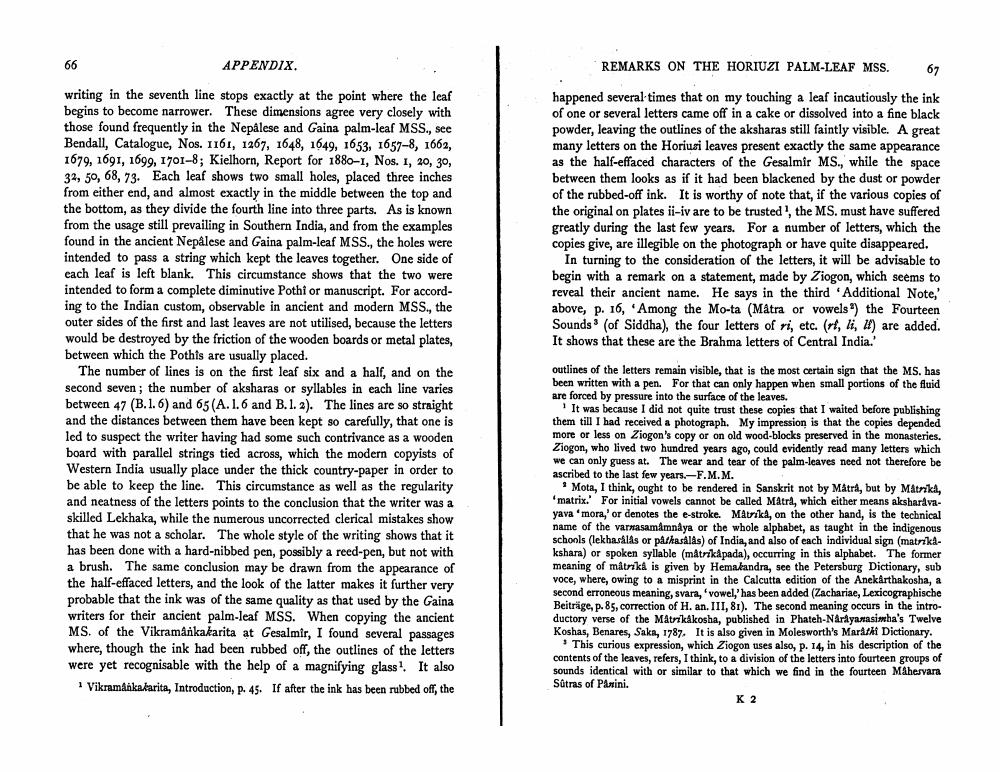________________
APPENDIX
REMARKS ON THE HORIUZI PALM-LEAF MSS.
67
happened several times that on my touching a leaf incautiously the ink of one or several letters came off in a cake or dissolved into a fine black powder, leaving the outlines of the aksharas still faintly visible. A great many letters on the Horiusi leaves present exactly the same appearance as the half-effaced characters of the Gesalmir MS., while the space between them looks as if it had been blackened by the dust or powder of the rubbed-off ink. It is worthy of note that, if the various copies of the original on plates ii-iv are to be trusted, the MS. must have suffered greatly during the last few years. For a number of letters, which the copies give, are illegible on the photograph or have quite disappeared.
In turning to the consideration of the letters, it will be advisable to begin with a remark on a statement, made by Ziogon, which seems to reveal their ancient name. He says in the third 'Additional Note,' above, p. 16, Among the Mo-ta (Mátra or vowels) the Fourteen Sounds' (of Siddha), the four letters of ri, etc. (rt, li, 2) are added. It shows that these are the Brahma letters of Central India.
writing in the seventh line stops exactly at the point where the leaf begins to become narrower. These dimensions agree very closely with those found frequently in the Nepalese and Gaina palm-leaf MSS., see Bendall, Catalogue, Nos. 1161, 1267, 1648, 1649, 1653, 1657-8, 1662, 1679, 1691, 1699, 1701-8; Kielhorn, Report for 1880-1, Nos. I, 20, 30, 32, 50, 68, 73. Each leaf shows two small holes, placed three inches from either end, and almost exactly in the middle between the top and the bottom, as they divide the fourth line into three parts. As is known from the usage still prevailing in Southern India, and from the examples found in the ancient Nepalese and Gaina palm-leaf MSS., the holes were intended to pass a string which kept the leaves together. One side of each leaf is left blank. This circumstance shows that the two were intended to form a complete diminutive Poth or manuscript. For according to the Indian custom, observable in ancient and modern MSS., the outer sides of the first and last leaves are not utilised, because the letters would be destroyed by the friction of the wooden boards or metal plates, between which the Pothis are usually placed.
The number of lines is on the first leaf six and a half, and on the second seven; the number of aksharas or syllables in each line varies between 47 (B.1.6) and 65 (A. 1.6 and B. 1. 2). The lines are so straight and the distances between them have been kept so carefully, that one is led to suspect the writer having had some such contrivance as a wooden board with parallel strings tied across, which the modern copyists of Western India usually place under the thick country-paper in order to be able to keep the line. This circumstance as well as the regularity and neatness of the letters points to the conclusion that the writer was a skilled Lekhaka, while the numerous uncorrected clerical mistakes show that he was not a scholar. The whole style of the writing shows that it has been done with a hard-nibbed pen, possibly a reed-pen, but not with a brush. The same conclusion may be drawn from the appearance of the half-effaced letters, and the look of the latter makes it further very probable that the ink was of the same quality as that used by the Gaina writers for their ancient palm-leaf MSS. When copying the ancient MS. of the Vikramankakarita at Gesalmir, I found several passages where, though the ink had been rubbed off, the outlines of the letters were yet recognisable with the help of a magnifying glass! It also
Vikramáhkatarita, Introduction, p. 45. If after the ink has been rubbed off, the
outlines of the letters remain visible, that is the most certain sign that the MS. has been written with a pen. For that can only happen when small portions of the fluid are forced by pressure into the surface of the leaves.
It was because I did not quite trust these copies that I waited before publishing them till I had received a photograph. My impression is that the copies depended more or less on Ziogon's copy or on old wood-blocks preserved in the monasteries. Ziogon, who lived two hundred years ago, could evidently read many letters which we can only guess at. The wear and tear of the palm leaves need not therefore be ascribed to the last few years.-F.M.M.
Mota, I think, ought to be rendered in Sanskrit not by Mátra, but by Matrika, "matrix. For initial vowels cannot be called Mátra, which either means akshardvayava mora,' or denotes the e-stroke. Maurik, on the other hand, is the technical name of the varnasamámnaya or the whole alphabet, as taught in the indigenous schools (lekhasilas or påskasálas) of India, and also of each individual sign (matrikkshara) or spoken syllable (matrikåpada), occurring in this alphabet. The former meaning of måtrika is given by Hemalandra, see the Petersburg Dictionary, sub voce, where, owing to a misprint in the Calcutta edition of the Anekarthakosha, a second erroneous meaning, svara, vowel,'has been added (Zachariae, Lexicographische Beiträge, p. 85, correction of H. an. III, 81). The second meaning occurs in the introductory verse of the Matrikakosha, published in Phateh-Narayarasimha's Twelve Koshas, Benares, Saka, 1787. It is also given in Molesworth's Marathi Dictionary.
This curious expression, which Ziogon uses also, p. 14, in his description of the contents of the leaves, refers, I think, to a division of the letters into fourteen groups of sounds identical with or similar to that which we find in the fourteen Mahesvara Sutras of Panini.
K 2




